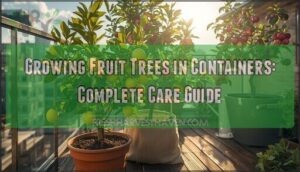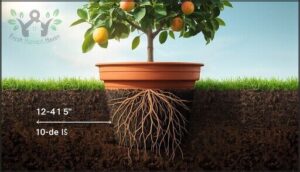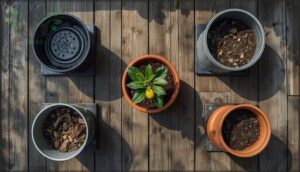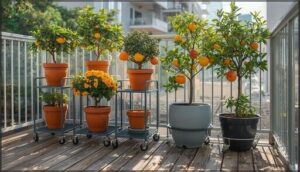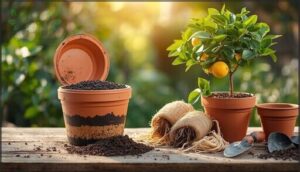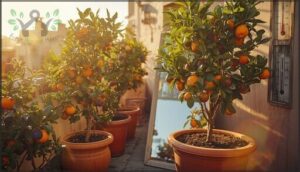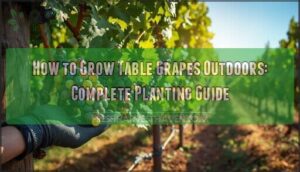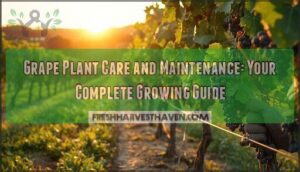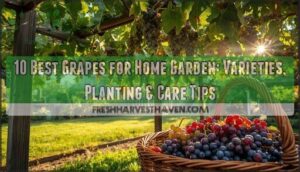This site is supported by our readers. We may earn a commission, at no cost to you, if you purchase through links.
Most gardeners assume you need a sprawling backyard to grow fruit trees, but a 15-gallon pot and a sunny balcony can produce the same harvest as a small orchard plot. Growing fruit trees in containers breaks the tyranny of geography—no yard, no problem.
Dwarf Meyer lemons stay compact at four feet tall, semi-dwarf apples deliver sixty percent of standard yields, and fast-growing mulberries thrive in tight quarters with zero compromise on flavor.
The secret isn’t luck or endless space; it’s choosing the right varieties and dialing in container specs, soil chemistry, and care routines that turn potted trees into prolific producers. Master these fundamentals, and you’ll harvest fresh fruit on your terms, whether you’re working with a postage-stamp patio or a rooftop garden.
Table Of Contents
- Key Takeaways
- Choosing Fruit Trees for Containers
- Selecting The Right Container
- Preparing Ideal Potting Soil
- Essential Care and Maintenance
- Optimizing Growing Conditions and Harvest
- Frequently Asked Questions (FAQs)
- How do you grow a fruit tree in a container?
- Can a fruit tree grow in a container?
- Can fruit trees grow in pots?
- What fruit trees grow in containers?
- How big should a fruit tree be in a container?
- When should you plant a fruit tree in a container?
- What is the easiest fruit tree to grow in a container?
- Do fruit trees grow well in pots?
- Can you grow fruit trees in 5 gallon buckets?
- Do fruit trees do well in pots?
- Conclusion
Key Takeaways
- Dwarf and semi-dwarf fruit tree varieties like Meyer lemons, mulberries, and apples thrive in 15-20 gallon containers, producing 40-60% of standard orchard yields without requiring yard space.
- Container success hinges on proper drainage systems, well-aerated potting mix with 25% air-filled porosity, and maintaining soil pH between 6.0-6.5 with consistent fertilization during active growth.
- Self-fertile cultivars eliminate the need for multiple trees in small spaces, with varieties like ‘Redhaven’ peach yielding 15-25 pounds per season when given 6-8 hours of daily sunlight.
- Disease-resistant rootstock cuts pest management workload by 38%, while strategic winter pruning boosts blossom potential by 40% and proper root management every 2-3 years prevents yield losses of 8-15%.
Choosing Fruit Trees for Containers
You can’t just grab any fruit tree and expect it to thrive in a pot—container growing demands specific varieties that won’t outgrow their space or collapse under their own weight. The right selection hinges on understanding mature size, pollination requirements, and natural disease resistance before you commit to a cultivar.
Here’s what separates container-worthy champions from backyard disappointments.
Best Dwarf and Semi-Dwarf Varieties
Breaking free from orchard constraints starts with smart variety selection. Dwarf Improved Meyer Lemon Trees thrive in containers, staying 4–6 feet tall while delivering sweet fruit. Dwarf Everbearing Mulberry Trees grow fast with hardy vigor, perfect for compact growth in limited spaces. Semi-dwarf apples in 15–20 gallon pots produce 40–60% of standard orchard yields. Container gardening for fruit trees maximizes fruit yield without sacrificing tree size control.
Effective study habits, including AP exam resources, can also improve overall gardening knowledge.
Self-Fertile Options for Small Spaces
You don’t need multiple trees to harvest in tight quarters. Self-fertile varieties like ‘Redhaven’ peach produce 15–25 lb per season in containers, while Meyer lemon yields 10–40 fruits annually.
For small space gardening success with dwarf varieties:
- Use 18–24 inch diameter pots for root stability
- Maintain soil quality with pH 6.0–7.0
- Apply balanced fertilizer monthly during growth
- Provide 6–8 hours sunlight for fruit tree care
Container gardening liberates you from orchard limitations. Effective literature reviews help gardeners make informed decisions about their gardening practices.
Selecting Disease-Resistant Trees
Disease resistance cuts your pest management workload by 38% in container trials—fire blight-resistant pears and powdery mildew-tolerant peaches lead the pack. Dwarf varieties like the Improved Meyer Lemon Tree naturally resist many pathogens, while breeding programs deliver cultivars that thrive without heavy chemical inputs.
Pathogen control starts at selection: choose trees engineered for fruit health, and you’ll spend less time fighting problems, more time harvesting.
Selecting The Right Container
Your container choice determines whether your fruit tree thrives or struggles from day one. The right pot provides adequate root space, proper drainage, and the structural support your tree needs as it matures and bears fruit.
The right container provides adequate root space, proper drainage, and structural support your fruit tree needs to thrive from day one
Let’s break down the key factors you need to examine when selecting containers that’ll set your trees up for long-term success.
Minimum Size and Depth Requirements
Your container’s dimensions directly determine whether your fruit tree will thrive or merely survive. For dwarf and semi-dwarf varieties, you’ll need a pot volume of 5–10 gallons minimum, with container depth reaching 12–24 inches to accommodate the root ball size plus adequate soil depth.
This ensures proper tree anchorage and prevents nutrient dilution—critical factors in successful container gardening tips for growing fruit trees in containers.
Pot Materials and Drainage Needs
Beyond pot size, your container selection and preparation demand attention to material and drainage systems—both directly affect root health and soil moisture control. Terracotta pots offer excellent porosity but require more frequent watering in hot climates, while plastic retains moisture longer. Self-watering containers can cut daily irrigation by 40%, giving you freedom from constant monitoring.
- Verify drainage hole area equals 1/6 to 1/4 of the pot’s surface to prevent water logging
- Incorporate a 15–20% slope in the container base for improved drainage and healthier roots
- Use cushioning materials under metal or ceramic pots to reduce heat transfer in full sun
- Choose potting soil with excellent drainage properties to maintain ideal soil moisture levels
- Avoid flat-bottomed containers in clay, as sloped bases outperform them in preventing root suffocation
Mobility and Space-Saving Solutions
When floor space is scarce, mobility transforms your container gardening setup. Rolling casters with locks let 42% of growers chase sunlight across patios without hauling heavy pots. Mobile systems with lightweight materials slash total weight by 25%, giving you freedom to reconfigure on demand.
Vertical gardening through multi-tiered racks doubles your planting area, while compact planters with dwarf varieties keep trees within balcony widths of 1.0–1.5 m.
Preparing Ideal Potting Soil
Your potting medium makes or breaks container fruit production—forget that soggy garden dirt. You need a custom blend that drains fast, feeds consistently, and gives roots room to breathe without compacting over time.
Here’s how to build soil that actually works for potted trees.
Well-Draining Potting Mix Recipes
You need a potting mix that breathes—think of it as your tree’s lifeline against root rot. Combine one part soilless medium with one part aged compost and one part perlite or pumice to hit that 25% air-filled porosity sweet spot.
Alternatively, blend coconut coir (40–60%), perlite (30–50%), and compost (10–20%) for enhanced drainage systems and moisture retention in your containers.
Soil PH and Nutrient Balance
Most fruit trees thrive around pH 6.0–6.5, but you’ll need Soil Testing every 6–12 weeks to dial in your Nutrient Cycling. Aim for a 1:0.8:1 nitrogen-phosphorus-potassium ratio during active growth—tissue analysis at flowering and mid-season sharpens your Fertilizer Strategies.
If leaves yellow, chelated iron corrects Micronutrient Balance within weeks. Maintain pH Management with controlled-release formulations to prevent lockouts and keep your Plant Nutrition dialed in.
Organic Matter and Fertilizer Choices
Your mix needs both structure and nutrition—think one‑part sand, one‑part peat, one‑part perlite as your base. Amend with 10–20% compost or worm castings to lift organic matter by 3–6% and release steady nitrogen.
Apply Compost Tea every 2–4 weeks during growth to maintain Micronutrient Management, or top‑dress monthly with slow‑release 10‑10‑10 Organic Fertilizers at 1–2% of pot volume for balanced Tree Nutrition and Fertilization without leaching.
Essential Care and Maintenance
You’ve got your tree planted in the right container with quality soil—now the real work begins. Keeping your potted fruit tree productive means mastering a few core practices that differ from in-ground growing.
Let’s break down the watering schedules, pruning methods, pest control strategies, and root management techniques you’ll need to maintain a thriving container orchard.
Watering and Feeding Frequency
You control your tree’s destiny through precise watering schedules and fertilizer types. Check soil moisture at 1–2 inches deep; most container fruit trees need water every 2–4 days in warm weather, adjusted for pot size and tree nutrition needs.
Apply slow-release fertilizers twice per growing season, or liquid feed every 2–4 weeks during active growth.
Irrigation methods like drip systems paired with mulch improve nutrient cycling while preventing waterlogged roots.
Pruning and Training Techniques
Strategic pruning and training techniques give you dominion over your container fruit trees’ yield and vigor. Winter pruning during dormancy can boost blossom potential by up to 40%, while summer branch pruning increases fruit size by 12–18% through improved light penetration.
Training systems like espalier enhance fruiting surface area by 60–75%, and root management during repotting maintains ideal shoot-to-root ratios for sustained container growth.
Pest and Disease Management
Healthy trees start with vigilance—weekly canopy inspections catch 70–90% of pest colonies before they explode. Aphids and scale can slash fruit set by 20–40%, while poor drainage invites Phytophthora root rot.
Horticultural oil reduces mites by 40–70%, and releasing predatory mites delivers 60–80% suppression.
Disease prevention hinges on sanitation: prune deadwood, remove debris, and sterilize tools between cuts for ironclad fungal management.
Repotting and Root Pruning
Once sanitation locks out pathogens, repotting techniques and root pruning keep your potted fruit trees thriving long-term. Every 2–3 years for young rootstock—4–5 for mature containers—you’ll upgrade pot size, renew soil, and trim circling roots.
Cutting back one-third of primary roots stimulates feeder growth within four weeks, preventing bind stress that cuts yield by 8–15%. Container gardening for beginners? Master these pruning schedules and watch your trees flourish.
Optimizing Growing Conditions and Harvest
You’ve planted your tree, dialed in the soil, and mastered the watering routine—now it’s time to fine-tune the environment so your container fruit actually produces.
Light exposure, thermal stress management, and knowing when to pick all determine whether you get a handful of mediocre fruit or baskets full of flavor.
Let’s break down how to optimize yield and quality in your mobile orchard.
Sunlight and Temperature Requirements
Most container fruit trees need 6–8 hours of direct sunlight to hit their stride—citrus and stone fruits especially won’t compromise on light quality. Temperature tolerance matters too: aim for 65–85°F during fruit ripening, and watch for rootball heating in dark pots that can shift water needs.
Southern exposures and microclimates around walls extend your harvest window in container gardening.
Overwintering and Frost Protection
Beyond the growing season, your potted fruit trees demand winter care that separates survival from freeze damage. Root insulation and cold hardiness measures protect what matters most in container gardening for small spaces:
- Wrap pots with bubble wrap or burlap to hold 2–3°C warmth at root level
- Move containers to south-facing walls or unheated garages below 15°F
- Raise pots 15–30 cm off frozen ground using casters
- Mulch heavily around the container base with 5–10 cm straw
Frost protection isn’t optional—it’s your insurance policy for overwintering success with tree care fundamentals.
Harvesting Tips for Container-Grown Fruit
Timing your harvest transforms ordinary fruit tree care and maintenance into peak fruit production and harvesting. You’ll recognize fruit maturity when citrus reaches 9–12 °Brix and apples hit their color break—usually within 2–3 week windows.
Pick every 4–7 days during peak season for yield optimization, then refrigerate within 2 hours to lock in fruit quality and extend shelf life through proper post-harvest care in your container gardening for fruit production setup.
Frequently Asked Questions (FAQs)
How do you grow a fruit tree in a container?
You’re liberating edibles from ground constraints—choose dwarf cultivars, prepare well-draining potting mix, guarantee proper drainage, maintain consistent water management, and prune annually.
Root care and container preparation transform tight quarters into productive orchards.
Can a fruit tree grow in a container?
Yes—dwarf fruit trees thrive in containers when you choose the right tree variety and provide adequate container size, quality growing medium, and proper fruit tree care.
Root growth depends on soil quality, directly impacting fruit yield in container gardening with dwarf fruit trees.
Can fruit trees grow in pots?
Like transplanting freedom into a five-gallon bucket, dwarf varieties thrive in pots when you master container materials, soil quality, and water management.
Transforming balconies into productive orchards requires strategic root health maintenance and proper drainage systems.
What fruit trees grow in containers?
Dwarf citrus trees like Meyer lemon thrive in containers, alongside compact figs, pomegranates, and dwarf apples. Choose varieties bred for restricted root zones—they’ll reward your space with genuine harvests.
How big should a fruit tree be in a container?
You’ll want your container fruit tree to stay between 4 and 6 feet tall for easy management.
Root confinement and regular pruning techniques naturally keep dwarf varieties compact while maintaining healthy production in small space gardening setups.
When should you plant a fruit tree in a container?
Planting after the last spring frost boosts establishment success by 30%, especially in temperate zones.
This seasonal consideration ensures ideal container timing when soil temperatures exceed 60°F, supporting healthy root development and climate factors alignment.
What is the easiest fruit tree to grow in a container?
You’ll find that citrus trees—especially the Dwarf Improved Meyer Lemon Tree—are among the simplest for container growing, thriving in well-draining soil and adapting readily to most climates with minimal fuss.
Do fruit trees grow well in pots?
Think of roots as anchored freedom—container growing unlocks fruit production even without traditional garden beds.
Dwarf varieties excel in pots, yielding 1–15 pounds annually when you master soil quality, container sizing, and water management fundamentals.
Can you grow fruit trees in 5 gallon buckets?
Yes, 5-gallon buckets work for dwarf citrus and compact varieties with proper drainage, root pruning every 2–3 years, and quality growing medium—though mature canopy size remains limited by container volume and root health management.
Do fruit trees do well in pots?
Container-grown dwarf varieties achieve 70–90% survival rates with proper care, yielding fruit 60–90% the size of field-grown trees.
Your small space gardening success hinges on drainage, sunlight, and consistent potted tree care and maintenance.
Conclusion
Most orchardists spend decades tending acres of land, yet you can outpace their per-square-foot yields with a single potted tree and disciplined care. Growing fruit trees in containers strips away the romance of sprawling groves and replaces it with something better: measurable control over every variable that determines harvest success.
Your balcony becomes a precision growing system where rootstock selection, substrate chemistry, and environmental manipulation matter more than acreage ever could.

